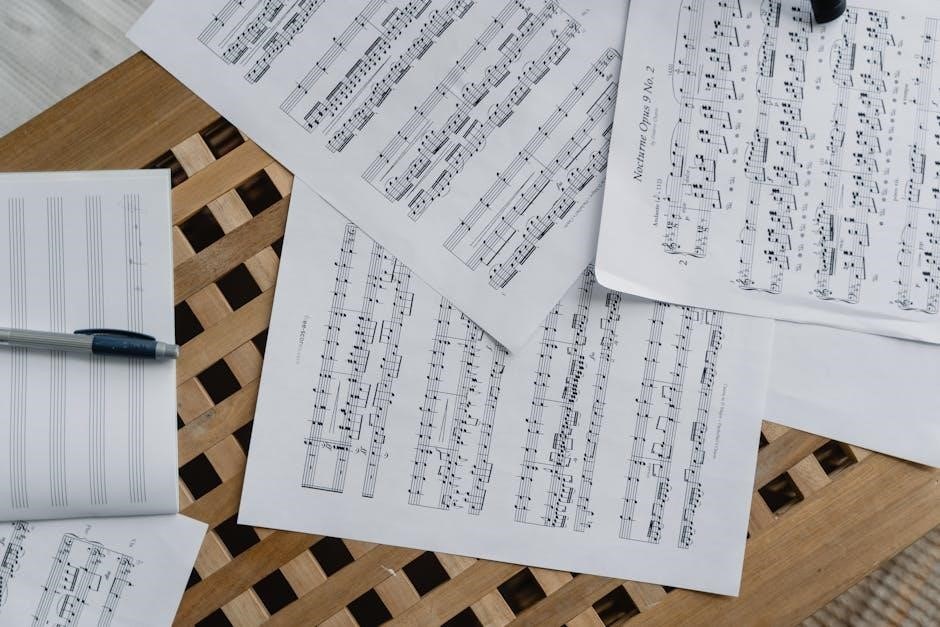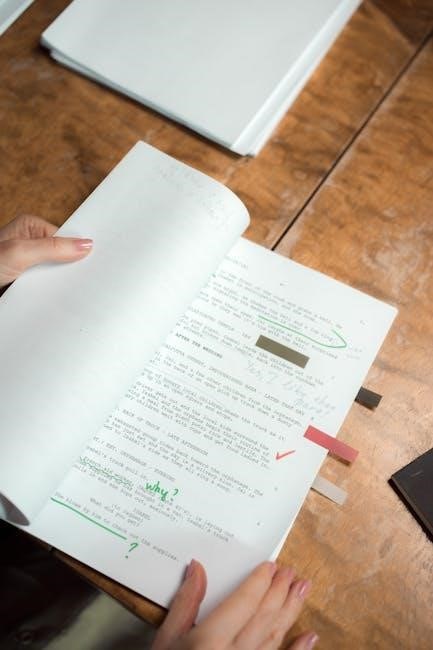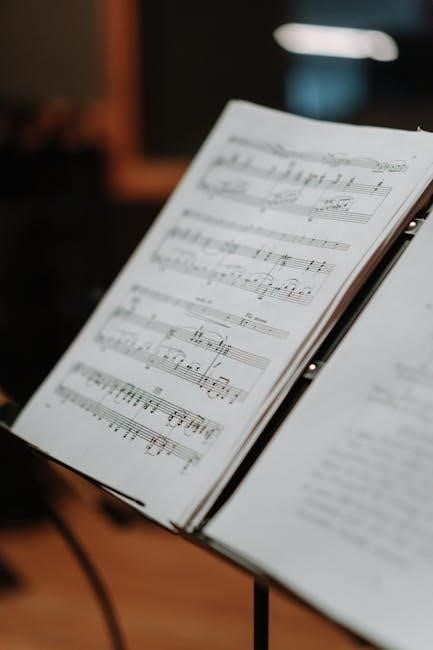
The Study of Orchestration, Fourth Edition, offers a comprehensive guide to mastering orchestral composition․ Renowned composer Samuel Adler provides in-depth insights, practical exercises, and real-world applications, making it an essential resource for musicians and composers seeking to enhance their orchestration skills․
1;1 Overview of the Fourth Edition
The Fourth Edition of The Study of Orchestration by Samuel Adler represents a significant enhancement in music education․ It incorporates updated exercises, expanded coverage of orchestral instruments, and case studies from master composers․ This edition emphasizes practical learning through a workbook with diverse activities, including “Test Yourself” assessments to gauge understanding․ Detailed music examples and accompanying audio resources provide immersive learning opportunities․ The book is widely regarded for its clarity and depth, making it an indispensable tool for both students and professional composers․ Its structured approach ensures a comprehensive understanding of orchestration techniques, aligning with modern composition practices and educational needs․
1․2 Importance of Orchestration in Music Composition
Orchestration is a cornerstone of music composition, enabling artists to transform musical ideas into vibrant, layered soundscapes․ It bridges the gap between creativity and technical execution, allowing composers to maximize the expressive potential of each instrument․ Mastery of orchestration enhances a composer’s ability to convey emotion, texture, and depth in their work․ The Fourth Edition of The Study of Orchestration underscores this importance, providing practical tools and insights to refine orchestral techniques․ By understanding how to effectively utilize instruments, composers can achieve their artistic vision with precision and impact, making orchestration an indispensable skill in the world of music creation and performance․
1․3 Key Features of the Fourth Edition
The Fourth Edition of The Study of Orchestration introduces enhanced learning tools, including updated exercises and “Test Yourself” activities․ It features detailed coverage of orchestral instruments, providing insights into their unique characteristics and roles within an ensemble․ The edition also incorporates case studies from master composers, offering real-world examples of orchestration techniques․ Additionally, the workbook includes an answer key and solutions, aiding students in self-assessment and improvement․ These features collectively create a comprehensive and interactive learning experience, making the Fourth Edition an invaluable resource for both students and educators in the field of music composition and orchestration․

Background and Significance of the Book

The Study of Orchestration, authored by Samuel Adler, is a cornerstone in music education, offering a comprehensive exploration of orchestral techniques and instrumentation․
2․1 Author Samuel Adler and His Contributions
Samuel Adler, a distinguished composer and educator, has significantly influenced music education through his work․ His book, The Study of Orchestration, is a cornerstone in the field, providing detailed insights into orchestral techniques and instrumentation․ Adler’s contributions include practical exercises, real-world applications, and case studies from master composers, making the text invaluable for students and professionals alike․ His expertise as a composer, with works performed by major orchestras worldwide, lends authority to the material․ The fourth edition is renowned for its comprehensive approach, offering a blend of theoretical knowledge and practical tools, thus solidifying its place as a leading resource in modern music education․
2․2 Historical Context of Orchestration Studies
The study of orchestration has evolved significantly since its origins in early ensemble music․ From classical composers like Haydn and Mozart to modern masters, orchestration techniques have expanded, reflecting changing musical styles and instrumental capabilities․ The 19th century saw detailed treatises emerge, with Berlioz and Wagner pioneering orchestration as a formal discipline․ In the 20th century, new technologies and compositional approaches further enriched the field․ Today, resources like The Study of Orchestration integrate historical insights with contemporary practices, offering a comprehensive understanding of orchestral composition․ This evolution underscores the importance of orchestration studies in music education and composition․
2․3 Evolution of the Book Through Editions
First published in 1982, The Study of Orchestration has undergone significant updates across its four editions․ The Fourth Edition, released in 2016, builds on Samuel Adler’s extensive experience, incorporating modern compositional techniques and expanded coverage of orchestral instruments․ New exercises, case studies from master composers, and enhanced digital resources reflect evolving pedagogical needs․ This edition also addresses contemporary topics, ensuring relevance for today’s musicians․ Each revision has strengthened the book’s position as a leading educational resource, blending tradition with innovation to meet the demands of modern music education and composition․

Structure and Content of the Fourth Edition
The Fourth Edition of The Study of Orchestration includes a comprehensive workbook with practical exercises, detailed coverage of orchestral instruments, and case studies from renowned composers․
3․1 Workbook and Exercises for Practical Learning
The workbook in the Fourth Edition of The Study of Orchestration is designed to reinforce theoretical concepts through hands-on exercises․ It includes “Test Yourself” activities, which allow students to assess their understanding of key orchestration principles․ These exercises cover a range of topics, from clef exercises and bowing techniques to string harmonics and transcription tasks․ By engaging with these practical assignments, students can apply their knowledge of orchestral instruments and scoring techniques, developing the skills necessary to compose effectively for various ensembles․ The exercises are structured to cater to students of all skill levels, ensuring a comprehensive learning experience․
3․2 Detailed Coverage of Orchestral Instruments
The Fourth Edition of The Study of Orchestration provides an in-depth exploration of orchestral instruments, focusing on their unique characteristics, timbre, range, and technical capabilities․ The text delves into the specific roles of strings, woodwinds, brass, and percussion, offering insights into their historical development and modern usage․ Practical examples illustrate how each instrument can be effectively utilized in various musical contexts․ This detailed coverage enables composers to make informed decisions when scoring for orchestral ensembles, ensuring a balanced and expressive sound․ The section also highlights the importance of understanding each instrument’s strengths and limitations for creating cohesive and engaging musical compositions․
3․3 Examples and Case Studies from Master Composers
The Fourth Edition of The Study of Orchestration enriches its pedagogical approach by incorporating examples and case studies from master composers․ These meticulously chosen excerpts, ranging from classical to contemporary works, demonstrate the practical application of orchestration techniques․ By analyzing scores from renowned composers, students gain insights into the creative decisions behind iconic orchestral pieces․ These examples serve as a bridge between theory and practice, offering learners a deeper understanding of how orchestration contributes to the emotional and structural impact of music; This feature equips aspiring composers with the skills to emulate and innovate upon the traditions established by musical legends․

The Workbook for the Study of Orchestration
The workbook complements the main text with practical exercises, including “Test Yourself” activities, to reinforce understanding and application of orchestration techniques through hands-on practice․
4․1 Types of Exercises and Activities
The workbook includes a variety of exercises designed to enhance orchestration skills․ “Test Yourself” activities assess comprehension of key concepts, while clef exercises improve notation accuracy․ Bowing exercises focus on string techniques, and harmonic exercises explore pitch manipulation․ Transcription tasks involve arranging pieces for different ensembles, reinforcing understanding of instrumental timbres․ Listening and scoring exercises develop aural skills, linking theoretical knowledge to practical application․ These activities cater to diverse skill levels, ensuring comprehensive learning and mastery of orchestration principles through hands-on practice․
4․2 Test Yourself Activities for Student Assessment
The “Test Yourself” activities in the workbook are designed to assess students’ understanding of orchestration concepts․ These exercises include scoring exercises, transcription tasks, and instrumental technique questions, allowing students to apply their knowledge pragmatically․ Immediate feedback is provided through the answer key, enabling self-assessment and identification of areas for improvement․ These activities align with the workbook’s learning objectives, ensuring students grasp essential skills in orchestration․ Regular assessment through these tasks helps track progress and reinforces key principles, making them an invaluable tool for both independent study and classroom instruction․
4․3 Answer Key and Solutions for Exercises
The answer key and solutions for exercises in the workbook provide detailed explanations for all activities․ This resource helps students verify their work and understand correct methods․ Each solution is clearly presented, offering insights into complex orchestration techniques․ The answer key is particularly useful for self-study, allowing learners to identify mistakes and improve independently․ It also serves as a teaching aid for educators, ensuring accurate feedback․ By aligning with the exercises, the answer key enhances the overall learning experience, making it an indispensable companion for mastering orchestration․

Digital and PDF Versions of the Book
The Study of Orchestration, 4th Edition, is available in digital and PDF formats, offering convenience and accessibility․
The PDF version can be downloaded legally from authorized sources, ensuring easy access for students and composers worldwide․
5․1 Availability and Accessibility of the PDF
The Study of Orchestration, Fourth Edition, is widely available in PDF format through digital platforms and online libraries like Z-Library․
Students and composers can easily access the PDF version, either by purchasing it directly from authorized sources or downloading it from legal platforms․
This accessibility ensures that learners worldwide can benefit from Samuel Adler’s expertise, enhancing their orchestration skills and understanding of musical composition․
The PDF format allows for convenient reading on various devices, making it a popular choice for both educational and professional use․
5․2 Benefits of the Digital Format
The digital format of The Study of Orchestration, Fourth Edition, offers unparalleled convenience and accessibility․
Students can easily access the PDF on various devices, including tablets, laptops, and smartphones, making it ideal for on-the-go learning․
The digital version also allows for instant searches, bookmarking, and highlighting, enhancing the learning experience․
Additionally, the PDF format ensures that the content remains crisp and clear, preserving the intricate details of musical scores and examples․
This modern approach caters to the needs of today’s learners, providing a flexible and efficient way to study orchestration․
5․3 Legal Sources for Downloading the PDF
To legally obtain the PDF of The Study of Orchestration, Fourth Edition, consider purchasing it from reputable sources․
Z-Library and similar platforms offer access, but ensure compliance with copyright laws․
The official publisher, W․ W․ Norton & Company, provides digital versions through their website or authorized retailers like Amazon․
Additionally, some universities and libraries offer access to the eBook through their databases․
Always prioritize legal sources to support the author and publisher while ensuring a high-quality, virus-free download experience․

Supplementary Materials and Resources
The Fourth Edition is supported by enlarged music examples, scores, and accompanying audio content․ These resources enhance learning, offering practical insights and real-world applications for composers and students․
6․1 Enlarged Music Examples and Scores
The Fourth Edition includes enlarged music examples and scores, providing clear visual aids for students․ These resources help in understanding complex orchestral arrangements and instrumentation techniques․ By examining masterpieces from renowned composers, learners can analyze and apply these methods in their own work․ The detailed scores offer a practical approach to studying orchestration, making abstract concepts more tangible․ This feature is particularly beneficial for visual learners, allowing them to grasp intricate musical structures and arrangements effectively․ The enlarged examples ensure that every detail is visible, aiding in comprehensive comprehension and application of orchestration principles․ This enhances the overall learning experience, making the study of orchestration more engaging and effective․
6․2 Accompanying Audio and Multimedia Content
The Fourth Edition is complemented by audio and multimedia resources, enhancing the learning experience․ Students can access recordings of orchestral pieces, allowing them to hear how instruments blend and interact․ These resources include masterclasses and interactive exercises, providing practical insights into orchestration techniques․ The multimedia content bridges theory and practice, enabling students to apply their knowledge effectively․ This integrated approach fosters a deeper understanding of orchestral composition and performance, making the study of orchestration engaging and comprehensive․ The availability of these materials ensures that learners can explore orchestration in a dynamic and immersive way, enhancing their skills and creativity․

6․3 Online Forums and Communities for Discussion
Online forums and communities dedicated to The Study of Orchestration, Fourth Edition provide a vibrant space for discussion and collaboration․ Platforms like Z-Library and specialized music education forums host active discussions among students, educators, and professionals․ These communities share insights, resources, and experiences, fostering a collaborative learning environment․ Many groups offer access to supplementary materials, such as enlarged scores and audio examples, further enriching the study experience․ By engaging with these forums, learners can gain diverse perspectives, address challenges, and stay updated on the latest developments in orchestration․ These online spaces play a crucial role in connecting the global community of music enthusiasts and practitioners․

Reception and Reviews of the Fourth Edition
The fourth edition of The Study of Orchestration is highly regarded for its comprehensive approach․ It is an essential resource for musicians, offering practical exercises and in-depth insights․ Students and educators praise its clarity and effectiveness, solidifying its position as a leading educational tool in music composition and orchestration․
7․1 Feedback from Students and Educators
Students and educators widely acclaim the fourth edition of The Study of Orchestration for its clarity and depth․ Many highlight its practical exercises and real-world examples, which enhance learning․ The workbook’s “Test Yourself” activities are particularly praised for reinforcing key concepts․ Educators appreciate the comprehensive coverage of orchestral instruments and the inclusion of case studies from master composers․ The book’s structured approach makes it accessible to both beginners and advanced students․ Feedback consistently underscores its value as an essential tool for mastering orchestration, with many considering it a top choice for music composition and theory courses․ Its impact on music education is undeniable․
7․2 Critical Acclaim in the Music Education Field
The Study of Orchestration, Fourth Edition, has received widespread critical acclaim for its meticulous approach to teaching orchestration․ Experts praise its comprehensive coverage of instruments, practical exercises, and insightful case studies from master composers․ The book is frequently adopted in university curricula and endorsed by leading composers and educators․ Its clarity and depth make it a cornerstone in music education, bridging theory and practice effectively․ Reviewers highlight its ability to engage both novice and advanced learners, solidifying its reputation as a definitive resource․ This edition continues to set standards in the field, ensuring its relevance for future generations of musicians and composers․
7․3 Comparisons with Previous Editions
The fourth edition of The Study of Orchestration builds upon the success of its predecessors, introducing enhanced features that elevate its educational value․ Compared to earlier editions, the fourth edition includes updated exercises, expanded instrument coverage, and improved multimedia resources․ Readers and educators have noted that these additions make the material more accessible and engaging․ The workbook now offers more interactive elements, such as “Test Yourself” activities, which were not as prominent in previous versions․ Additionally, the inclusion of digital formats and accompanying audio content provides a more immersive learning experience․ These improvements have solidified the book’s position as a leading resource in orchestration studies, ensuring its continued relevance and effectiveness for both students and professionals․
The Study of Orchestration, Fourth Edition, solidifies its position as a leading resource in music education․ Its comprehensive approach and digital innovations pave the way for future updates, ensuring continued relevance in modern composition and education․
8․1 Impact of the Book on Music Education
The Study of Orchestration, Fourth Edition, has profoundly influenced music education by providing a structured, practical approach to learning orchestration․ Its detailed exercises, real-world examples, and multimedia resources have made it an indispensable tool for students and educators alike․ The book’s focus on both theoretical and practical aspects ensures that learners gain a holistic understanding of orchestral techniques․ Additionally, its availability in digital formats and supplementary materials has enhanced accessibility and engagement, making it a cornerstone in modern music education curricula․ This edition continues to set a high standard for orchestration studies, fostering creativity and technical mastery in composers worldwide․
8․2 Potential Updates and Future Editions
Future editions of The Study of Orchestration could incorporate emerging technologies, such as interactive scoring tools and immersive multimedia․ Expanding coverage of diverse musical genres and contemporary composing techniques may also be explored․ Additionally, integrating AI-driven exercises or real-time feedback systems could enhance learning․ The inclusion of more global musical influences and collaborative projects with modern composers might further enrich the content․ Accessibility improvements, such as enhanced digital formats, could also be prioritized․ These updates would ensure the book remains a leading resource for music education, adapting to evolving industry standards and student needs while maintaining its core educational excellence․

8․3 The Role of the Book in Modern Composition
The Study of Orchestration, Fourth Edition, plays a pivotal role in modern composition by bridging traditional techniques with contemporary practices․ It equips composers with practical skills to adapt to diverse musical genres and technological advancements․ The book’s emphasis on detailed instrument analysis and real-world applications ensures relevance in today’s dynamic musical landscape․ Composers can apply its principles to create innovative scores for film, video games, and experimental music․ By fostering a deep understanding of orchestration, it empowers creators to push boundaries while respecting foundational elements, making it an indispensable tool for both education and professional composition in the modern era․